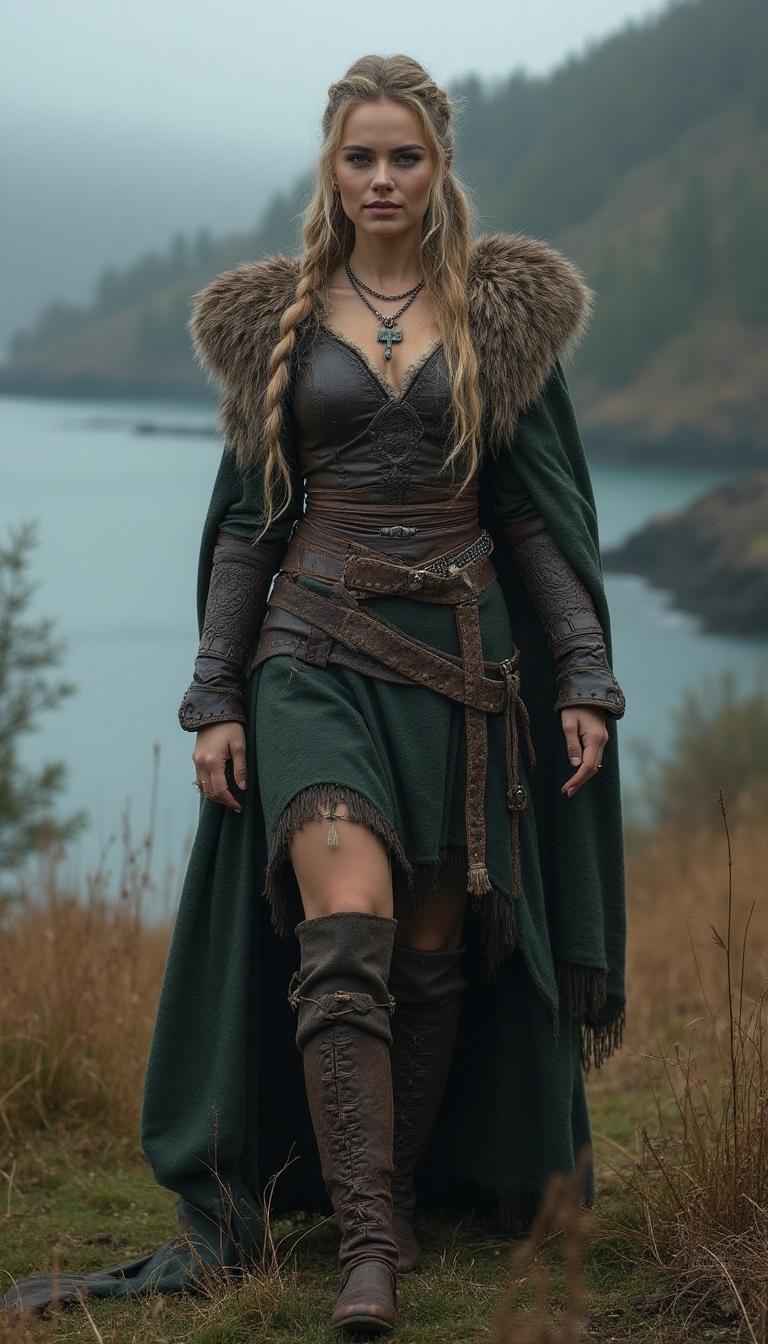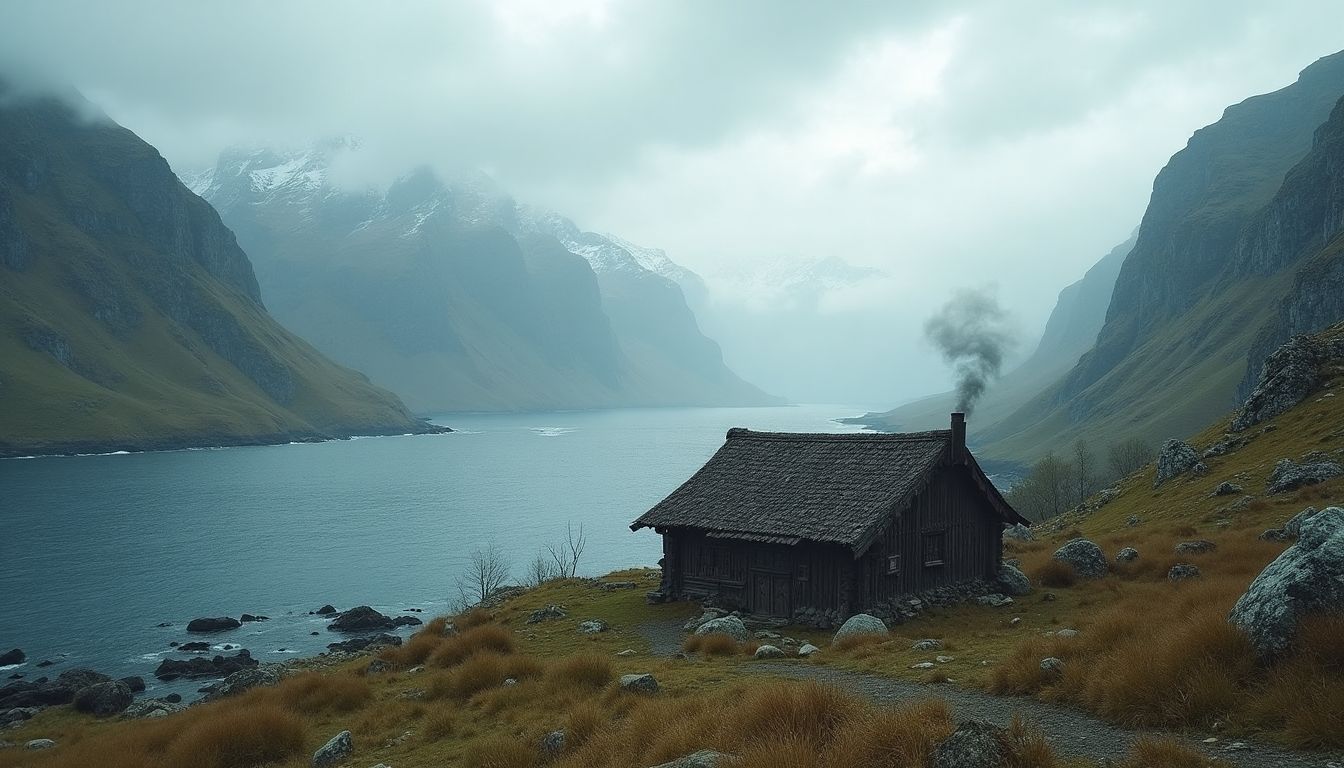Inside the Mind of a Viking Shieldmaiden: Strength and Sacrifice in a Misty Fjord
Viking shieldmaidens, cloaked in elegance, wielding swords, and fiercely defending their communities from threats, are some of history’s most captivating figures. These warrior women navigated a realm marked by the clash of swords and the depth of their own identities, forging paths defined by both strength and sacrifice. But what does it truly mean to be a shieldmaiden in a time steeped in brutal warfare and complex social structures? Let’s journey through the life of Astrid, a shieldmaiden in the late 9th century, as we unravel her background, challenges, and the hidden burdens that shaped her world.
Character Profile
- Name: Astrid
- Occupation: Shieldmaiden
- Era / Historical Period: Late 9th century
- Location: The misty fjords of Norway
- Affiliation: Clan Berengar
- Tools / Gear / Attire: A richly dyed green wool cloak, dark leather bodice, intricate jewelry, sword, and round shield
- Known Logs / Missions: Defended against rival clans, participated in raids, served as a diplomatic envoy
- Related Media / Interviews / Articles: Engravings from Norse sagas, artifacts in the Viking Ship Museum, and documented accounts from historians
What Does a Shieldmaiden Do?
Being a Viking shieldmaiden is not just about donning armor and engaging in battle. Picture this: a modern firefighter plunging into flames. That’s not far off from Astrid’s daily life. She trains rigorously, wielding her sword with the same ferocity as a skilled athlete, while constantly honing her tactical mind. Shieldmaidens were essential in protecting their villages, taking on combat roles typically reserved for men, and sometimes even leading their clans into battle. They were also involved in community decisions, forging treaties, and defending their families. Much like today's social workers, they fostered connections, valued community ties, and understood the emotional fabric of their tribe.
A Day in the Life of Astrid
Imagine stepping into Astrid's world just before dawn. The air is crisp, filled with the scent of the fjord, and the call of seabirds awakens the village. Clad in her leather bodice and woolen cloak, she prepares for a long day.
She begins her morning by practicing with her sword and shield at the beach, the sun breaking through mist, illuminating her disciplined form. She recalls her first time facing a steely foe at the age of 16 during a raid; adrenaline coursed through her veins, fear and excitement battling within her breast. “What if I falter?” she remembers thinking. But as she trained, she learned not only to fight but to lead. Quickly, those fears turned to resolve.
After training, she assists with communal farming, helping grow crops that fuel the clan. In afternoons, she gathers with fellow shieldmaidens, discussing strategies and ancient lore passed down from the elders. There’s a deep camaraderie among them, forged in laughter and camaraderie, but also in the shared weight of responsibility. Each woman knows that they not only fight for themselves but for their families and futures.
As the evening drapes its cloak over the fjord, they hold council meetings, where men and women alike gather to discuss impending threats—a rival clan plotting a raid, a looming storm that could wash away a year’s harvest. It’s a precarious balance she navigates, grappling with duties as a warrior and as a woman in a male-dominated society. The weight can feel suffocating. Does her valor shine as brightly in waiting than in battle?
The Complexity of Identity
Astrid’s identity as a shieldmaiden transcends her role as a fighter; it intertwines with her womanhood. “What if I am too fierce?” she wonders. Unlike her male counterparts, whose identities are often rigidly defined by their combat prowess, Astrid faces the societal expectation of nurturing and caregiving. Shieldmaidens had to navigate this duality, embodying both the ferocity of a warrior and the grace of a woman caring for family and home.
In one poignant moment, Astrid dons her cloak for a ceremonial event hosted by the clan elder. The vibrant green cloth represents her community, yet she feels the internal struggle—a reminder of the sacrifices made for war and family. Chronically tired, she leans into her role but questions if there’s room for her own dreams amidst this collective identity.
Reflection on the Burdens
The burden of a shieldmaiden is far from romantic. For Astrid, the fear of loss looms large. In the wake of a tragic raid that saw dear friends fall, there’s a palpable grief that lingers. She writes in her personal diary:
“Today we returned from the churning seas, and I feel the weight of our departed in every breath. My heart pounds, not from battle, but from the realization that my strongest shield does not protect against loss. Is there a day when the scars will fade, or will I forever carry this weight?”
Astrid’s philosophy centers around bravery as a form of vulnerability—a willingness to embrace both the sword and sorrow. Warriors are not merely made of steel; they are also spun from emotional threads that weave the fabric of their humanity. It is this duality that enriches a shieldmaiden's life while reminding them of the costs of their bravery.
Exploring Parallels Across Time
When we reflect on Astrid's life, consider this question: What if a modern-day woman of strength, like a firefighter or a social worker, stepped into her shoes? Both worlds share a balance of courage and compassion, an exploration of roles defined by societal expectations, and a struggle against the pull of duty versus desire. Today’s women still carry the weight of multi-faceted identities.
As we honor Astrid’s legacy, we see echoes in contemporary struggles—what if we embraced our vulnerabilities as strengths, as shieldmaidens did?
Conclusion: A Call to Conversation
Reflecting on Astrid’s journey leaves us with bold questions: What hidden burdens do we overlook in our own lives? How can we honor the complexities of our identities in a world eager to simplify us? Would we, too, wield our swords in the face of adversity, like Astrid, or retreat into shadows, burdened by expectations?
Join us as we delve deeper into the inspiring legacies of women across time. Subscribe to the newsletter and become a resident of the "Shining City on the Web" for more stories that matter: Subscribe now. Like, share, and challenge these narratives—let’s engage in a meaningful conversation on the complexities of identity and strength. As we honor the past, we empower the future.
The Green Cloak
The fjord was silent but alive, a breath held between mountains.
Astrid walked the shoreline barefoot, her steps slow and soundless. The tide was low, and scattered bits of broken shell crunched beneath her heels. A grey gull screamed in the mist above. The world was damp, soft, and listening.
She was not armored. Not today. Just the cloak—wool, green as pine bark after rain, heavy with dew and time.
She was returning from the mountain. From the grave.
They had buried Halla beneath stone and ash. No pyre. There had been no wood to spare. And the wounds had been too many, the flesh too torn. So Astrid chose the old way. The earth way. She dug until her fingers bled, and when the rocks were placed, she pressed her forehead to them in silence. No song. No speech. Just breath.
She had loved Halla. Not in the way the stories told—no dramatic confessions, no stolen kisses by firelight—but in the way that two souls recognize something fierce and alike in one another and choose, again and again, to walk beside it.
Now she walked alone.
The village below the cliff was still, smoke curling from thatched roofs, chickens scratching near wet stones. Astrid passed them all. The children did not run to her as they used to. They watched now. They sensed what death had carved into her.
She stepped into her hall. Removed her boots. Sat. And for the first time in weeks, she wept. Quietly. As if her tears were embarrassed to fall.
The next morning, she rose before the sun. The air was crisp, edged with salt and frost. The green cloak had dried stiff, and she pulled it over her shoulders with the weight of a story. It smelled of lichen and sweat and fire.
She did not go to the training grounds.
Instead, she walked to the woods beyond the ridge, where the moss was thick and the soil sank underfoot. This was where her mother had taken her as a child. To learn names. Birch. Alder. Bonewort. Vulture grass. To track the pawprint of a lynx. To read the wind.
She found a patch of dry ground beneath a bent pine and sat, drawing her knife slowly across her palm. Not deep—just enough.
The blood welled red and bright. She touched it to the bark, whispering words in the old tongue. A promise. Or maybe a question.
What is left of me when all that I fought for is gone?
Days passed. Then weeks.
She returned to her duties, but not as before. Something had changed. The fire had shifted. She still sparred—faster than any of the new recruits. Still offered counsel, still fixed armor, still helped with the goats and salted the fish. But she no longer volunteered for raids. No longer sought glory.
One evening, the clan's new seer—a boy barely past his naming—told her he’d had a dream of her wielding flame in both hands.
Astrid only smiled. “Fire burns the bearer too.”
Later, as she stared into her hearth, her mind wandered.
There had been a man once, in her twentieth year. A trader with kind eyes and fingers that smelled of cedarwood and ink. He'd asked her to come with him—to Iceland, to Dublin, to far ports where no one knew her name.
She had considered it. Had even packed a small satchel.
But when the longship moored, she had not stepped aboard.
Her place was here. Among the stones. Among the dead.
That winter, a storm came unlike any they had seen. The sea rose angry and white, and the sky wept snow for six days without pause.
When it cleared, half the fishing stores had frozen. The nets were torn. The livestock shivered thinly in the wind.
There was talk of leaving. Of breaking the clan and heading south to warmer lands.
Astrid said nothing for two days.
Then, without word, she packed her gear, donned her green cloak, and set out across the ice.
They watched her go, thinking she would return with firewood or meat. They did not expect what she would bring back.
She returned ten days later—half-starved, her eyes hollow, but dragging behind her a sled of rare herbs and salt-dried fish. She had bartered with a widow living alone in the fjord’s north mouth—given her a carved necklace and her own shield in exchange. On her return, she had slain a bear—not for glory, but for warmth and food.
The clan survived the rest of the winter because of that journey.
No one called her a hero.
But a small girl left a pinecone on her doorstep the next morning, bound in red string.
Astrid placed it beside her bed, where no one could see.
Time folded. Years passed like waves—sometimes violent, sometimes slow.
She watched old friends grow tired, watched children take up spears. She stopped attending feasts. Her green cloak faded to moss, frayed at the hem, stained with smoke.
One spring, the jarl died. In his place rose a woman—Eydis—young, fierce, brilliant. Astrid saw in her a storm barely contained. She offered her sword. Eydis refused.
“I want your wisdom, not your weapon.”
So Astrid became a teacher.
She taught them not only how to kill, but when to walk away. How to stitch wounds. How to read silence in a hall.
Once, she stood before the circle of women and said, “To be a shieldmaiden is not to be made of stone. It is to be the sea: soft, deep, and dangerous.”
They remembered those words.
They remembered her.
The night before her death, Astrid walked alone to the stones above the village—where the sea and sky met like old lovers. She wore the green cloak one last time.
In her satchel, she carried a small knife, three dried berries, and a letter written in runes no one alive could read.
She lay down facing the fjord. Let the wind take her breath.
And when they found her in the morning, she looked not dead, but returned—her mouth slightly parted, as if she had whispered something to the sky before it answered.
They buried her where she lay.
And the clan never fought a losing war again.
Some say the cloak still hangs in the longhouse.
Others say it dissolved into the mist.
But everyone agrees: she stood.
Not just in war.
But in sorrow.
In silence.
In the long days after the drums stopped.
She stood.
And because of her, others learned how to carry weight without breaking.
How to be fierce and kind.
How to live a life that leaves no statue—but lingers like smoke, like song, like memory.
Like a green cloak in the fog.
Disclaimer: This article may contain affiliate links. If you click on these links and make a purchase, we may receive a commission at no additional cost to you. Our recommendations and reviews are always independent and objective, aiming to provide you with the best information and resources.
Get Exclusive Stories, Photos, Art & Offers - Subscribe Today!

























Post Comment
You must be logged in to post a comment.